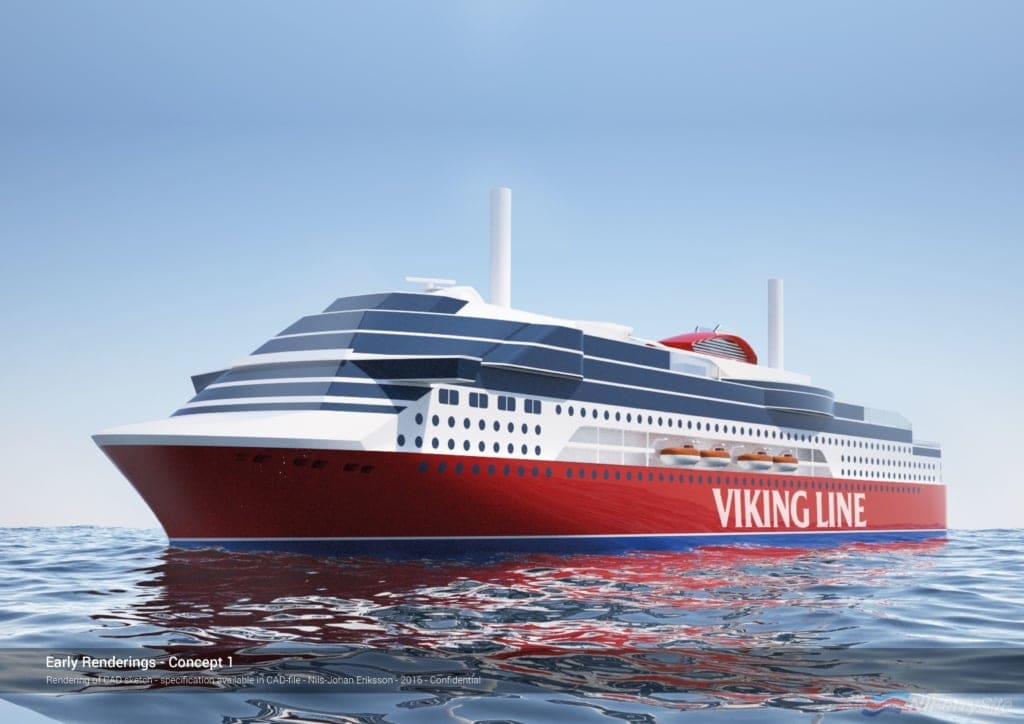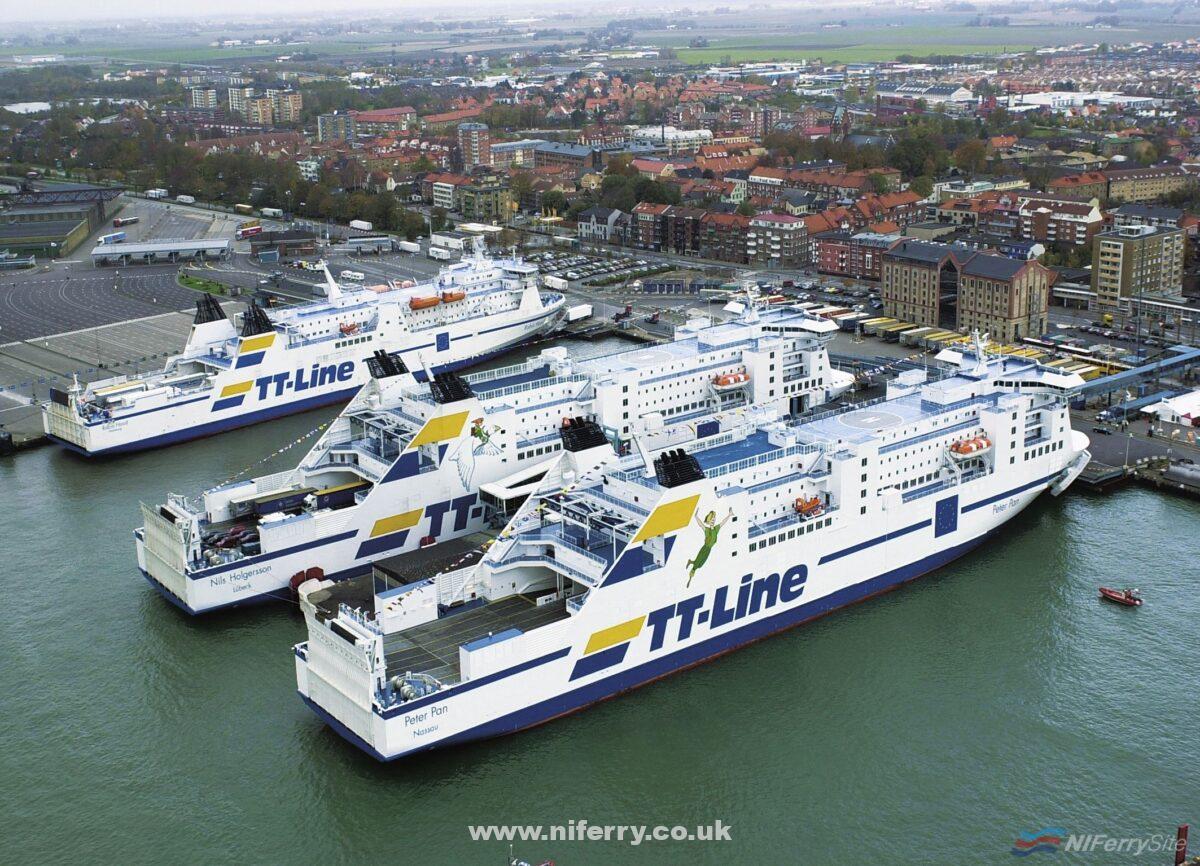Travemünde based TT-Line has officially signed a long awaited order for a new ferry with China’s Jinling shipyard. Despite previous suggestions that two vessels would be ordered by TT-Line, only one firm order has been placed with an option for another vessel. The new ship is expected to be delivered in 2022 and is based on the TT-Line “Greenship” design (external link) developed in collaboration with OSK-Shiptech. The order comes despite the lengthening of current vessel PETER PAN earlier this year and continues the surge in new ferry orders in the past couple of years.
“We foresee a continued demand growth for short sea services within the Baltic Sea. With this investment we can respond even more effectively to the needs of our customers and support them to grow,”
– Hanns H. Conzen, Managing Director of TT-Line
The new ship will be able to run on LNG (Liquid Natural Gas) or Diesel and according to TT-Line will have emissions 50% lower than the previous generation of vessels. The German Federal Ministry of Transport and Digital Infrastructure (BMVI) is to absorb the additional costs of installing LNG capability into the vessel (and the second one if the option is exercised), and has approved the order being placed with a Chinese yard. At present there are no permanent shoreside LNG bunkering facilities in Germany however, though TT-Line do intend to run the new vessel on LNG which has lower pollutant emissions than diesel.
“Sea transportation is the most environmentally efficient way of moving goods. TT-Line will set a new standard in terms of cutting harmful emissions by choosing LNG as a fuel for the innovative TT-Line Green Ship. This innovative and future-oriented TT-Line Green Ship will be the most environmentally friendly ro-pax ship in our trading area.”
– Bernhard J. Termühlen, CEO of TT-Line.
The first sketch of the new TT-Line ferry shows a ship with large windows for public areas which appear to be located above the bridge, and balconies for some cabins. According to TT-Line this generation has been designed with high efficiency and flexibility in mind, with a particular focus on reducing turnaround times.

TT-Line currently have 6 ferries which link Travemünde and Rostock (Germany), and Świnoujście (Poland) with the Swedish port of Trelleborg. At weekends they have a return sailing between Trelleborg and Klaipėda (Lithuania) as well as offering a single Rostock – Klaipėda – Travemünde rotation between Friday and Sunday.
“With the handing over of two further subsidy notifications, we are continuing the upgrading and conversion of marine vessels to LNG propulsion, thereby supporting the further reduction of emissions in shipping. I am pleased that the shipping line TT-Line is now following this path and thus becoming a model for environmentally friendly shipping traffic, “
– State Secretary Enak Ferlemann from the German Ministry of Transport
Technical Data
| TT-Line “Greenship” | |
| Builder | Jinling Shipyard, Jiangsu Provence, China |
| Length | 230m |
| Breadth | 31m |
| Gross Tonnage | 45,000 (approx) |
| Passenger Capacity | 800 |
| Freight Capacity | 4,600 lane metres (approx 200 freight units) |
| Classification | DNV-GL |
NIFS Comment
This latest order comes in addition to the orders that Jinling shipyard has already confirmed – twelve ro-ro’s for Grimaldi and Finnlines, six ro-ro’s for DFDS, and a second ro-ro for Australia’s Toll Shipping (the first of which TASMANIAN ACHIEVER II has recently been delivered). The TT-Line order represents a move into potentially more lucrative passenger ferry building for the Northern European market. Stena Line of course have also ordered Ro-Pax’s from China with eight confirmed E-flexer’s (two of which are for Brittany Ferries and one for DFDS) being built at AVIC Weihai, while DFDS themselves have an order for two Ro-Pax’s at GSI. GSI is already an established builder of passenger and vehicle ferries for Northern Europe having built the existing Destination Gotland vessels and their potential replacements which should soon be in service. The first of this new generation, VISBORG, was christened last week while the second is nearing completion. GSI also have orders for two Ro-Pax’s each for Italian operators GNV and Moby Lines (with options for two further vessels each), and a single Ro-Pax for Algerie Ferries which was recently started. This makes GSI the leading large Ro-Pax builder for the European market at present. Viking Line have a single order for a next generation Ro-Pax at Xiamen shipyard. A number of vessels are also on order from European yards such as FSG in Germany (including Irish Ferries W.B. YEATS and Brittany Ferries HONFLEUR), Visentini in Italy, and Rauma Marine Constructions in Finland. These orders are in contrast to the absence of new vessels in the past decade which has resulting in the Northern European fleet ageing, with a number of vessels over 30 years of age in service. Most of these new Ro-Ro’s and Ro-Pax’s incorporate lower emissions technology such as exhaust gas scrubbers, LNG or Diesel-Electric propulsion, or even electricity generating rotor sails. They have also been designed to be more efficient than previous generations through their incorporation of technology and modern hull design.

Further orders may also be placed in early 2019 with P&O Ferries said to be preparing to place an order for two new ferries for their Dover – Calais route from a yard in either Europe or Asia. These vessels could be a departure from the norm on the route, with speculation that they could be double-ended ferries which won’t need to turn around in port. Competitor DFDS of course are expecting to take delivery of an E-Flexer for the same route in 2021. DFDS are also rumoured to be contemplating placing an order for their Newcastle – Ijmuiden service to replace the current 1980’s built tonnage on the route KING SEAWAYS and PRINCESS SEAWAYS, though it is not yet clear if or when this will happen.
